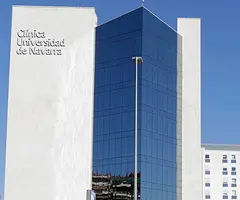Leukemia
"We offer you a personalized treatment according to your age and characteristics of your disease, with treatments that include chemotherapy, hypomethylating agents, new targeted therapies or transplantation of hematopoietic progenitors".
DR. ANA ALFONSO
SPECIALIST. HEMATOLOGY AND HEMOTHERAPY DEPARTMENT

Leukemias can be divided into three types. Chronic lymphatic leukaemia is the most common in Western countries, accounting for 30% of all leukaemias.
On the other hand, there is chronic myeloid leukemia, which is characterized by a predominant increase in the granulocytic series, and acute leukemias, neoplastic proliferations of immature hematopoietic cells.
The symptoms and prognosis depend on each type of leukemia, the phase in which the disease is found and the complications that may appear.
New drugs and new therapeutic strategies are being developed, not only to destroy the neoplastic cell, but also to inhibit its growth and promote its differentiation.
For example, retinoic acid derivatives, new monoclonal antibodies linked to chemotherapy or gene therapy.

A PERSONALIZED MEDICINE
Second Opinion,
peace of mind
Request a second opinion from our professionals with great experience in the diagnosis and treatment of oncological diseases
In 3 days, without leaving home.
What are the symptoms of leukaemia?
In some cases, leukaemia has no symptoms and is detected in routine tests
Fatigue (asthenia): A feeling of persistent fatigue, even after rest, that makes daily activities difficult.
Weight loss: Unintentional decrease in body weight without changes in diet or level of physical activity.
Bone pain: Discomfort or pain in the bones, caused by the accumulation of leukaemia cells in the bone marrow.
Anaemia: A decrease in red blood cells, resulting in paleness, weakness and shortness of breath.
Fever: An unexplained rise in body temperature, which may be persistent or intermittent.
Swollen lymph nodes (adenopathy): Enlarged lymph nodes, especially in the neck, armpits or groin.
Frequent infections: Increased susceptibility to infections such as pneumonia or shingles due to a weakened immune system.
Do you have any of these symptoms?
If you suspect that you have any of the above symptoms,
you should consult a medical specialist for a diagnosis.
Types of leukaemia
Chronic lymphocytic leukaemia (CLL)
It is the most common type of leukaemia in Western countries, accounting for about 30% of all cases. It originates in B lymphocytes, a type of white blood cell responsible for the immune response. It progresses slowly and often has no symptoms in its early stages. Over time, it can weaken the immune system and predispose to infections.
Chronic myeloid leukaemia (CML)
It is characterised by an abnormal growth of cells of the granulocytic series, a type of white blood cell responsible for defending against infection. In most cases, it is associated with a genetic alteration known as the Philadelphia chromosome. It has a progressive course with an initial chronic phase, followed by an accelerated phase and finally a more aggressive blastic phase.
Acute leukaemias
A group of diseases in which immature haematopoietic cells proliferate uncontrollably in the bone marrow, preventing the normal production of blood cells. There are two main types: acute lymphoblastic leukaemia (ALL), which is more common in children, and acute myeloid leukaemia (AML), which mainly affects adults. It progresses rapidly and requires immediate treatment.
Leukaemia prognosis
Until not so long ago, the mortality rate of acute leukaemia was very high in a short time. However, we can now speak of a cure for some specific types of acute leukaemia. In many other cases, a significant increase in survival has been achieved.
In chronic lymphocytic leukaemia, the prognosis depends on the stage of the disease. There are cases with the same survival as a person of the same age without chronic lymphocytic leukaemia.
However, in other more advanced stages, depending on prognostic factors, survival may be considerably lower.
Survival will also depend on the complications that may arise in the course of this leukaemia.
Diagnosis of leukaemia
Leukaemia is diagnosed through various tests to confirm the disease, determine its type and assess its extent. Initially, it is usually suspected by symptoms such as intense pallor, recurrent infections, high fever or haemorrhages. For confirmation, blood tests and a bone marrow puncture are performed, where the affected cells are studied.
In some cases, cytochemical techniques are used to differentiate leukaemia from other conditions with similar symptoms. Imaging tests, such as scans, are also used to assess lymph node, liver and spleen involvement, especially in chronic lymphoproliferative syndromes.
How is leukaemia treated?
In the case of lymphatic leukemia, the importance of correct staging lies in the fact that each stage of the disease will be treated in one way or another. The cases with the best prognosis may not receive treatment.
At present, fludarabine and other purine analogues have very good results. New biological therapies are used, such as monoclonal antibodies.
Treatment of chronic myeloid leukemia depends on the stage of the disease. Initially it is done with oral chemotherapy and immunotherapy, trying to control the great leukocytosis.
Patients in the phase of acceleration or transformation to acute leukemia should receive more aggressive treatments.
Once the disease has been controlled, the treatment will depend on the age of the patient:
Young patients with bone marrow donors may be submitted to bone marrow transplantation, the only curative treatment.
In older patients or those who do not have a bone marrow donor, a bone marrow autotransplant may be considered.
The treatment of acute leukemias is still chemotherapy today. The schemes vary depending on the type of acute leukemia. Likewise, bone marrow transplant plays a very important role in the treatment, either autologous (from the patient himself) or allogeneic (from a donor), depending on each case.
Nowadays new drugs and new therapeutic strategies are being developed, not only to destroy the neoplastic cell, but also to inhibit its growth and to favour its differentiation, such as retinoic acid derivatives, new monoclonal antibodies linked to chemotherapy or gene therapy.
What clinical trials do we have on leukemias?
Advanced Therapies Unit
The Advanced Therapies Unit of the Clínica Universidad de Navarra develops cell therapies against cancer and other diseases of the immune system.
It is implemented by a highly specialised multidisciplinary team of nurses, together with doctors from all the specialties involved.
Where do we treat it?
IN NAVARRA AND MADRID
The Hematology and Hemotherapy Service of the
at the Clínica Universidad de Navarra
The Hematology Service of the Clinic, formed by specialists of recognized national and international prestige, has integrated molecular diagnostic techniques and the use of new personalized treatments in its assistance work, allowing a more precise and fast diagnosis of the hematological diseases.
The joint work of the medical staff and the researcher facilitates the development and application of the new treatments and at the same time the precise evaluation of the result of the treatments.

Why at the Clinica?
- Experts in the development of Cellular Therapy treatments.
- International reference center in lymphomas, multiple myeloma and monoclonal gammopathies.
- Experts in the diagnosis and treatment of hemorrhagic and thrombotic problems.
Our leukaemia expert team





























